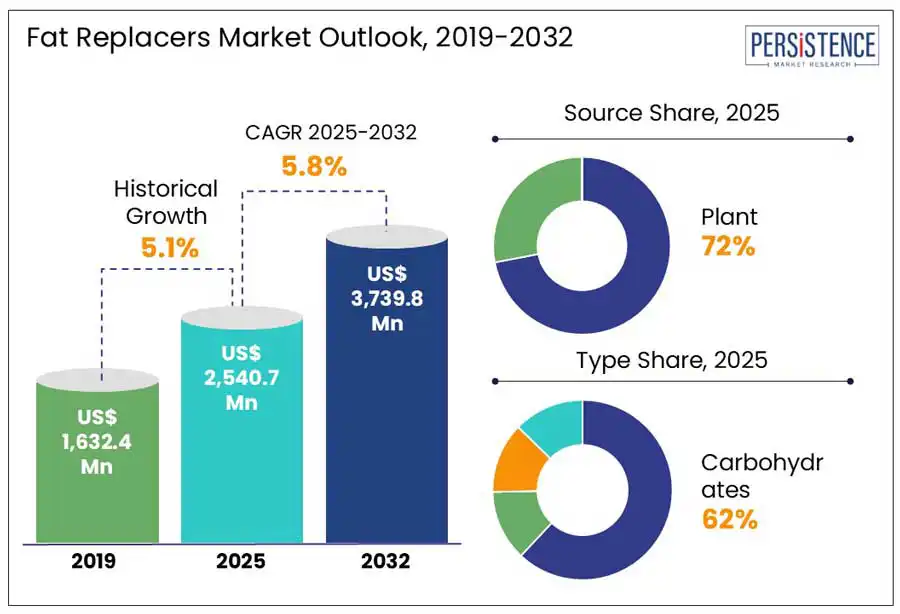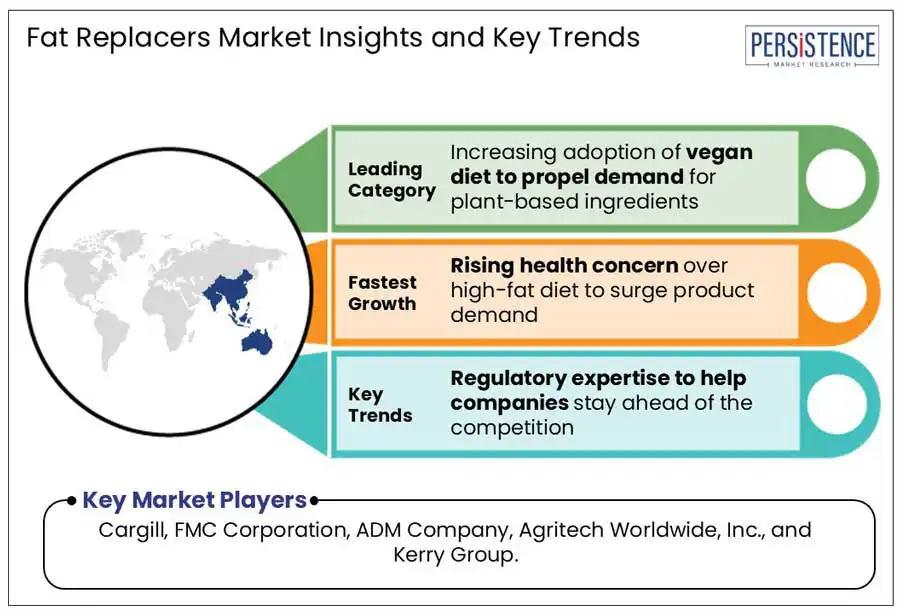Comprehensive Snapshot for Fat Replacers Market Including Regional and Country Analysis in Brief.
Industry: Food and Beverages
Published Date: April-2025
Format: PPT*, PDF, EXCEL
Delivery Timelines: Contact Sales
Number of Pages: 150
Report ID: PMRREP20044
The global fat replacers market size is anticipated to be valued at US$ 2540.70 Mn in 2025 and is projected to reach US$ 3739.80 Mn at a CAGR of 5.8% by 2032. As consumers become more health-conscious, the demand for fat replacers is rising, driven by an increasing desire for healthier, low-fat alternatives in everyday foods. The shift indicates calorie reduction and the growing need for clean-label, natural ingredients.
Food companies are responding with innovative solutions such as plant-based and carbohydrate-based fat replacers that allow consumers to indulge without compromising their health. For example, Barcelona-based Cubiq Foods combines cellular culture technologies, microencapsulation of Omega-3 oils, and advanced oil/water emulsions to create healthier fat alternatives for the food industry. Its innovative approach positions the company as a leader in industrial-scale applications for alternative fats. One of their key products, Go!Drop, offers improved juiciness, full flavor, fewer calories, less saturated fat, and 20% less oil.
Such initiatives by food technology companies are anticipated to create exciting growth opportunities in the forthcoming years.

Key Industry Highlights
|
Global Market Attribute |
Key Insights |
|
Fat Replacers Market Size (2025E) |
US$ 2540.70 Mn |
|
Market Value Forecast (2032F) |
US$ 3739.80 Mn |
|
Projected Growth (CAGR 2025 to 2032) |
5.8% |
|
Historical Market Growth (CAGR 2019 to 2024) |
5.1% |
The growing health concerns associated with high-fat diets such as increased risk of obesity, heart disease, stroke, and certain cancers are driving the demand for healthier food alternatives. According to TIME, more than half of the global population is projected to be classified as obese. These include a significant rise in childhood obesity rates, which are likely to double from 10% to 20% for boys and from 8% to 18% for girls in 2025. To address these alarming health trends, consumers are increasingly shifting toward low-fat and reduced-calorie food options without compromising taste and texture. This transition has led to manufacturers leveraging advanced food science to develop healthier alternatives using plant-based fibers, proteins, and carbohydrate-based substitutes.
Certain fat replacers, generally those derived from natural sources such as plant-based proteins or starches, have reduced oxidative stability and prone to microbial spoilage. This creates a problem with products without synthetic stabilizers or preservatives, where shelf-life is limited. For example, dairy alternatives such as oat or pea-based fat replacers require cold chain logistics, leading to high distribution costs and risk of spoilage. Development and production of new fat replacers with longer shelf life and improved stability is often an expensive affair, which include complying with regulatory standards of different regions. Such factors are therefore, likely to pose a challenge.
Companies that proactively navigate complex regulatory landscapes can launch products faster and with fewer setbacks. Building strong compliance capabilities or aligning with local regulatory experts creates a first-mover advantage, generally in regions where companies face delays. Formulating with GRAS (Generally Recognized As Safe) or already-approved ingredients helps brands avoid lengthy approvals and reduce risk. This strategy is likely to help companies ensure product rollouts and support product innovation in clean-label segments. Therefore, focusing on compliance expertise is projected to open up new growth opportunities for the market players during the forecast period.
Based on source, the plant segment is projected to dominate and account for 72% share in 2025. The dominance is attributed to growing consumer preference for natural, recognizable ingredients such as soy, pea protein, or oat fiber. In addition, the rising vegan population is driving the demand for plant-based diets globally. For example, as per studies, as of 2024, 1% to 2% of the global population is following a vegan diet, which constitutes to about 79 million to 160 million people.
Animal segment is likely to be the fast-growing segment during the forecast period. Animal-derived fat replacers such as whey proteins and gelatin offer superior texture and enhanced taste in certain applications. The growing demand for these replacers in the premium and performance nutrition categories is forecasted to drive the segment growth in the forthcoming years.
Based on type, the carbohydrate segment is projected to hold a share of approximately 62% in 2025, driven by increasing demand for cost-effective alternative to traditional fats. Sourced from common ingredients such as potatoes, corn, and oats, carbohydrate-based fat replacers are widely available and affordable. This further makes them appealing to large-scale manufacturing companies, which market their products such as ready-to-eat meals in cost-sensitive regions like Asia Pacific.
On the other hand, the protein segment is likely to witness considerable growth, fueled by technological advancements in the production of protein-based fat replacers. Companies are now using fermentation technologies to create fat-mimicking proteins with high functionality. For instance, in 2023, Mycorena, a Sweden-based food technology company, launched a fungi-based fat ingredient, Mycolein. This ingredient replicates the sensory and functional properties of animal fats in plant-based food products.

Asia Pacific is projected to account for a 42% market share in 2025 and further dominate during the forecast period. The dominance of the region is attributed to supportive government initiatives, growing awareness regarding functional benefits of fat replacers in food applications, and rising cases of coronary heart diseases. As per studies, by 2050, coronary heart disease cases in Asia Pacific are anticipated to hit 729.5 million, doubling from 2025 figures. Consumers in this region are seeking low-fat and low-calorie food products which is anticipated to boost the demand for fat replacers during the forecast period.
China is the largest producer and consumer of food products globally. In 2024, China’s agri-food industry output surpassed US$ 1.8 trillion, fueled by significant domestic demand and supportive government policies for food security. China’s shift towards convenient, processed, and functional food is likely to fuel demand for healthier options such as low-fat, fortified, and plant-based products.
North America is expected to witness considerable growth during the forecast period. Presence of established food manufacturing companies in the U.S., rising incidence of lifestyle diseases, and growing consumption of bakery & confectionery products are driving the growth of the market in this region. As per studies, the average person in the U.S. consumes around 53 pounds (24 kilograms) of bread every year.
To meet clean-label and low-fat demands, brands are reformulating products such as cookies, pastries, cakes, and chocolates using carbohydrate and protein-based fat replacers. These alternatives replicate the creamy, rich experience of traditional fats while improving nutritional profiles.
For instance, in July 2024, Bunge launched Beleaf PlantBetter, a plant-based butter substitute for bakery applications. This product replicates the sensory qualities of traditional dairy butter and integrates seamlessly into existing production processes, offering a natural ingredient texture.
Europe is anticipated to witness a steady growth during the forecast period. With consumer demand for functional foods rising, food manufacturers are focusing on to innovation to meet the growing preference for clean-label, low-fat products. For instance, in 2024 the approval of cellulose-based fat replacers by the European Food Safety Authority (EFSA) has been a key step in encouraging reformulations, enabling companies to cater to the growing preference for transparent, natural ingredients. Companies investing in the research and development of innovative products can tap into the rising trend of health-conscious consumers, especially as European governments are pushing for nutritional reforms.
Germany is experiencing substantial growth driven by the presence of a robust food processing industry and large-scale adoption of functional ingredients. Other countries such as the U.K. and France continue to lead the bakery and dairy segments, where fat reduction is critical, and are increasingly adopting plant-based and fiber-rich fat replacers to meet consumer demand for healthier food products.
The global fat replacers market is characterized by the presence of both established companies and innovative new entrants. To meet evolving consumer expectations, companies are investing heavily in research and development activities to introduce innovative fat substitute ingredients that closely replicate the texture and flavor of traditional fats, primarily using plant-based and protein-based alternatives. For instance, in March 2023, Shiru launched OleoPro, a plant-protein-based fat ingredient designed for alternative protein food products, boasting 90% less saturated fat.
Beyond innovation, companies are strengthening their market positions through strategic collaborations, partnerships, mergers, and acquisitions. These efforts aim to accelerate product development and expand technological capabilities to maintain their dominance during the forecast period.
|
Report Attribute |
Details |
|
Historical Data/Actuals |
2019 - 2024 |
|
Forecast Period |
2025 - 2032 |
|
Market Analysis |
Value: US$ Mn |
|
Geographical Coverage |
|
|
Segmental Coverage |
|
|
Competitive Analysis |
|
|
Report Highlights |
|
|
Customization and Pricing |
Available upon request |
By Source
By Type
By Form
By Application
By Region
To know more about delivery timeline for this report Contact Sales

The global market is projected to value at US$ 2540.70 Mn in 2025.
The market is driven by increasing demand for clean-labeled food products and technology innovation in food formulations.
The market is poised to witness a CAGR of 5.8% from 2025 to 2032.
Increasing focus on regulatory expertise and growing demand for functional food products are the key market opportunities.
Major players in the fat replacers industry include Cargill, FMC Corporation, ADM Company, Agritech Worldwide, Inc., and Kerry Group.